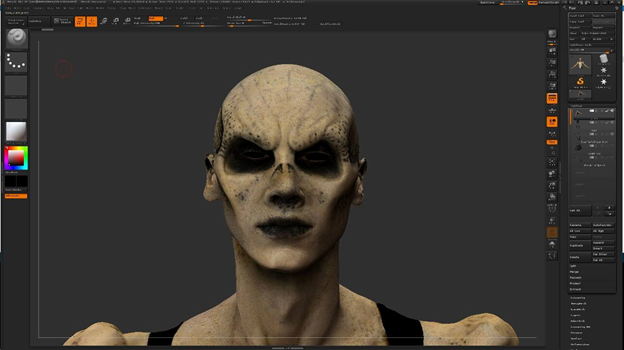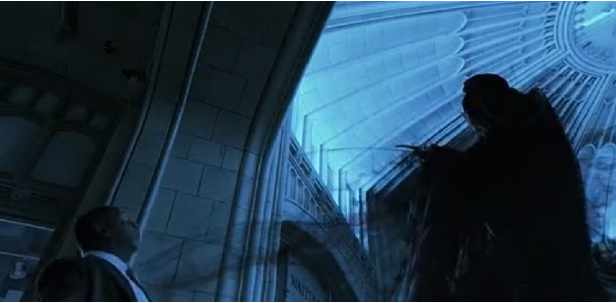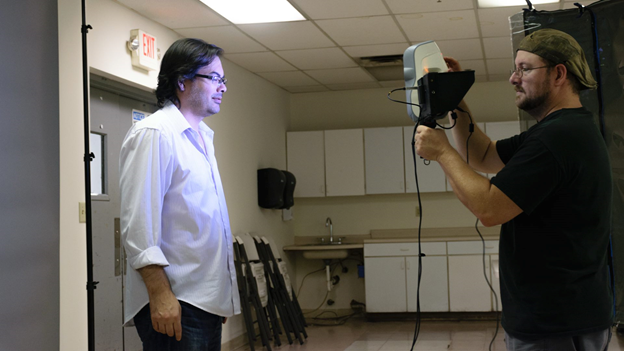Good special effects can make the difference between a mildly scary movie or TV show and one that can make you afraid to go to sleep at night. These days, 3D technology has a lot to do with creating the effects that give us the most serious cases of the creeps. 3D scanners, believe it or not, can do a lot to turn an ordinary human actor into a terrifying specter, as a visual effects team did for an episode of Fox’s Sleepy Hollow last season.
In Season 3, Episode 2, entitled “The Whispering Wraith,” a horrible wraithlike demon terrorizes people, sometimes to death. Although actor Alexander Ward, who played the wraith, is also a stuntperson, there are things a supernatural wraith demon needs to do that a human actor, no matter how talented, just can’t handle, so Ward needed to have a digital stunt double.
No problem, right? Actually, Ward’s costume presented a few challenges. His black robe was made of several different types of fabric, some transparent and mesh-like, and some with a shiny appearance. What are two of the most difficult things to 3D scan? Black objects and shiny objects – so the special effects team from Second Chance Games and Visual Effects (2CGVFX) had their work cut out for them.
Luckily, the team was armed with the Spider and Eva scanners from Artec 3D, which has built a reputation on being able to scan the unscannable (or at least the very difficult-to-scan). 2CGVFX Vice President Vic Holt used the Eva scanner to capture the robe, which required a lot of tweaking, of both scanner settings and surroundings.
“The settings had to be changed on the texture brightness bringing it down a small amount to take the glare off so the scanner could see better. Also, we adjusted the sensitivity up some and just had to move slow,” Holt said. “The robe weighed a good bit and we had the actor stand on a turntable with poles to rest his hands on keeping his elbows locked into position. We knew going in that the robe would probably fall off our very large turntable so I went to our shop and cut a larger piece of wood to be affixed to the top of it to hold the extra cloth material instead of it dragging on the floor when we spun him.”
Because the area to be scanned was so large, the team had to scan in multiple sections with lots of overlap. While Eva was used to capture the large amounts of fabric, the high-resolution precision Spider scanner was used for detailed facial areas. Holt created a rather ingenious system by hooking a special handle to one side of the scanners, while on the other side a small monitor was attached to the HDMI port on the computer so he could see what he was doing.
“It allowed me to see what I was scanning rather than having to look over at the computer,” Holt explained. “I just mirrored over the display and had Artec doing a Real Time Fusion while saving the raw scan file in the background.”
The team’s work still wasn’t done after they scanned Ward and his robe, however; they then had to scan him without it in case the fabric moved onscreen, exposing his chest area. Once that was done, all of the scans were rebuilt and remeshed in ZBrush so that they could be animated.
“So we basically had two separate scans to work on….the robe and the guy under it,” said Holt. “The mesh work needs to be done in a way that is optimized for animating as well as in not hindering in the rendering phase. We provide the model as optimized as possible so they easy to deal with by the vfx department.”
 I have to admit I’ve found myself watching frightening and/or violent scenes on TV recently and, rather than being fully caught up in the horror, musing about what kind of technology went into the effects – that’s the downside (or upside, maybe – less nightmares?) to working in the tech industry. Knowing how much work goes into just one scene or single effect, however, also generates a real sense of awe, and the skill of special effects teams – and the quality of their equipment – is very evident in shows like Sleepy Hollow, which Holt is a big fan of.
I have to admit I’ve found myself watching frightening and/or violent scenes on TV recently and, rather than being fully caught up in the horror, musing about what kind of technology went into the effects – that’s the downside (or upside, maybe – less nightmares?) to working in the tech industry. Knowing how much work goes into just one scene or single effect, however, also generates a real sense of awe, and the skill of special effects teams – and the quality of their equipment – is very evident in shows like Sleepy Hollow, which Holt is a big fan of.
“It’s been real fun creating digital doubles of wonderful creatures this show has developed,” he said. “Their attention to detail is quite evident in watching the show as my wife and I have done since its beginning.”
The devil is in the details, isn’t that what people say? In this case, the details are what make the devil – or at least a formidable demon. Discus in the Artec 3D forum at 3DPrint.com.
Subscribe to Our Email Newsletter
Stay up-to-date on all the latest news from the 3D printing industry and receive information and offers from third party vendors.
You May Also Like
NSF Awards Kentucky $1M for Advanced Manufacturing
The National Science Foundation has awarded a $1 million grant to the University of Louisville for the Advancing Manufacturing and Building Construction Technologies (NSF AMT) project. This initiative is part...
3D Printing News Briefs, May 11, 2024: 3D Printed Stent, Tower, Sculptures, & More
We’re starting off with medical research in today’s 3D Printing News Briefs, as researchers in Korea used CT images and 3D printing to fabricate an educational simulator for a mastoidectomy....
3D Printing Unpeeled: Wind Turbines, Probiotics and Lenses
TPI Composites, ORNL and Ingersoll Rand are working to make wind turbine tooling segments that can be 18.3 meters long. These elements also include resistive wires that help keep the...
Tethon 3D Releases Cost-effective Bioprinter
Tethon 3D, known for its ceramic-loaded DLP materials, custom resins, and DLP 3D printers, has recently released a bioprinter. Vat polymerization printers like DLP systems have been widely used by...




































